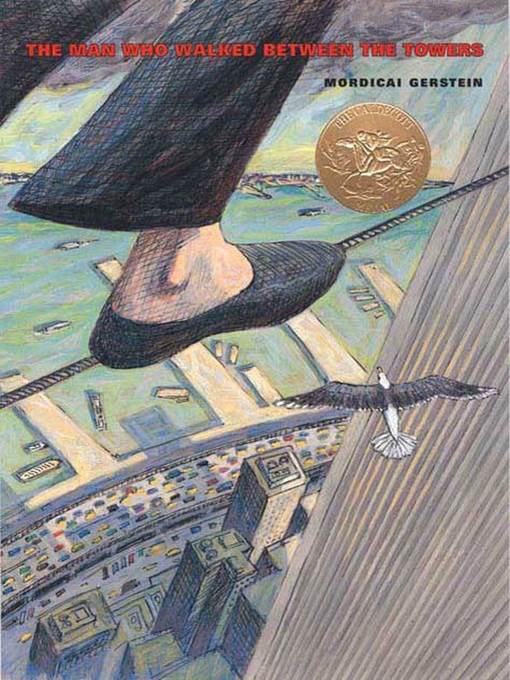
The Man Who Walked Between the Towers
فرمت کتاب
ebook
تاریخ انتشار
2007
Lexile Score
640
Reading Level
2
ATOS
3.7
Interest Level
K-3(LG)
نویسنده
Mordicai Gersteinناشر
Square Fishشابک
9781429939959
کتاب های مرتبط
- اطلاعات
- نقد و بررسی
- دیدگاه کاربران
نقد و بررسی

streak - The man who walked between the towers by Mordicai Gesrsein.Is a book about a man who walked between two towers and he got taken to court. I tell you what happened next. But first he pretended to be a construction worker and brought a cable up to the top of the tower. But he's got caught by the police.read the rest of the book find out what happened to him. This book has really good illustrations.

Starred review from September 1, 2003
This effectively spare, lyrical account chronicles Philippe Petit's tightrope walk between Manhattan's World Trade Center towers in 1974. Gerstein (What Charlie Heard) begins the book like a fairy tale, "Once there were two towers side by side. They were each a quarter of a mile high... The tallest buildings in New York City." The author casts the French aerialist and street performer as the hero: "A young man saw them rise into the sky.... He loved to walk and dance on a rope he tied between two trees." As the man makes his way across the rope from one tree to the other, the towers loom in the background. When Philippe gazes at the twin buildings, he looks "not at the towers but at the space between them.... What a wonderful place to stretch a rope; a wire on which to walk." Disguised as construction workers, he and a friend haul a 440-pound reel of cable and other materials onto the roof of the south tower. How Philippe and his pals hang the cable over the 140-feet distance is in itself a fascinating—and harrowing—story, charted in a series of vertical and horizontal ink and oil panels. An inventive foldout tracking Philippe's progress across the wire offers dizzying views of the city below; a turn of the page transforms readers' vantage point into a vertical view of the feat from street level. When police race to the top of one tower's roof, threatening arrest, Philippe moves back and forth between the towers ("As long as he stayed on the wire he was free"). Gerstein's dramatic paintings include some perspectives bound to take any reader's breath away. Truly affecting is the book's final painting of the imagined imprint of the towers, now existing "in memory"—linked by Philippe and his high wire. Ages 5-8.

Starred review from November 1, 2003
K-Gr 6-As this story opens, French funambulist Philippe Petit is dancing across a tightrope tied between two trees to the delight of the passersby in Lower Manhattan. Gerstein places him in the middle of a balancing act, framed by the two unfinished World Trade Center towers when the idea hits: "He looked not at the towers, but at the space between them and thought, what a wonderful place to stretch a rope-." On August 7, 1974, Petit and three friends, posing as construction workers, began their evening ascent from the elevators to the remaining stairs with a 440-pound cable and equipment, prepared to carry out their clever but dangerous scheme to secure the wire. The pacing of the narrative is as masterful as the placement and quality of the oil-and-ink paintings. The interplay of a single sentence or view with a sequence of thoughts or panels builds to a riveting climax. A small, framed close-up of Petit's foot on the wire yields to two three-page foldouts of the walk. One captures his progress from above, the other from the perspective of a pedestrian. The vertiginous views paint the New York skyline in twinkling starlight and at breathtaking sunrise. Gerstein captures his subject's incredible determination, profound skill, and sheer joy. The final scene depicts transparent, cloud-filled skyscrapers, a man in their midst. With its graceful majesty and mythic overtones, this unique and uplifting book is at once a portrait of a larger-than-life individual and a memorial to the towers and the lives associated with them.-Wendy Lukehart, Washington DC Public Library
Copyright 2003 School Library Journal, LLC Used with permission.

November 1, 2003
PreS-Gr. 3. Here's a joyful true story of the World Trade Center from a time of innocence before 9/11. In 1974 French trapeze artist Philippe Petit walked a tightrope suspended between the towers before they were completed. Gerstein's simple words and dramatic ink-and-oil paintings capture the exhilarating feats, the mischief, and the daring of the astonishing young acrobat. He knew his plan was illegal, so he dressed as a construction worker, and, with the help of friends, lugged a reel of cable up the steps during the night and linked the buildings in the sky. As dawn broke, he stepped out on the wire and performed tricks above the city. Gerstein uses varied perspectives to tell the story--from the close-up jacket picture of one foot on the rope to the fold-out of Petit high above the traffic, swaying in the wind. Then there's a quiet view of the city skyline now, empty of the towers, and an astonishing image of the tiny figure high on the wire between the ghostly buildings we remember.(Reprinted with permission of Booklist, copyright 2003, American Library Association.)

























دیدگاه کاربران